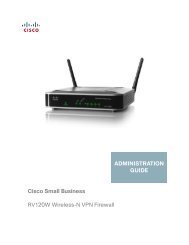Cisco WAP200 Wireless-G Access Point with PoE and ...
Cisco WAP200 Wireless-G Access Point with PoE and ...
Cisco WAP200 Wireless-G Access Point with PoE and ...
You also want an ePaper? Increase the reach of your titles
YUMPU automatically turns print PDFs into web optimized ePapers that Google loves.
<strong>Wireless</strong>-G <strong>Access</strong> <strong>Point</strong> <strong>with</strong> Power Over Ethernet <strong>and</strong> RangeboosterSSID. There are several things to keep in mind about the SSID:1. Disable Broadcast2. Make it unique3. Change it oftenMost wireless networking devices will give you the option of broadcasting the SSID. While this option may bemore convenient, it allows anyone to log into your wireless network. This includes hackers. So, don’t broadcastthe SSID.<strong>Wireless</strong> networking products come <strong>with</strong> a default SSID set by the factory. (The Linksys default SSID is “linksys”.)Hackers know these defaults <strong>and</strong> can check these against your network. Change your SSID to something unique<strong>and</strong> not something related to your company or the networking products you use.Change your SSID regularly so that any hackers who have gained access to your wireless network will have tostart from the beginning in trying to break in.MAC Addresses. Enable MAC Address filtering. MAC Address filtering will allow you to provide access to onlythose wireless nodes <strong>with</strong> certain MAC Addresses. This makes it harder for a hacker to access your network <strong>with</strong>a r<strong>and</strong>om MAC Address.WEP Encryption. Wired Equivalent Privacy (WEP) is often looked upon as a cure-all for wireless securityconcerns. This is overstating WEP’s ability. Again, this can only provide enough security to make a hacker’s jobmore difficult.There are several ways that WEP can be maximized:1. Use the highest level of encryption possible2. Change your WEP key regularlyWPA. Wi-Fi Protected <strong>Access</strong> (WPA) is the replacement st<strong>and</strong>ard for WEP in Wi-Fi security. Two modes areavailable: Personal, <strong>and</strong> Enterprise. Both give you a choice of two encryption methods: TKIP (Temporal KeyIntegrity Protocol), which utilizes a stronger encryption method <strong>and</strong> incorporates Message Integrity Code (MIC) toprovide protection against hackers, <strong>and</strong> AES (Advanced Encryption System), which utilizes a symmetric 128-Bitblock data encryption. Enterprise utilizes a RADIUS server for authentication <strong>and</strong> the use of dynamic TKIP, AES, orWEP.Important: Always remember that eachdevice in your wireless network MUST usethe same encryption method <strong>and</strong> encryptionkey or your wireless network will not functionproperly.Appendix B: <strong>Wireless</strong> SecuritySecurity Threats Facing <strong>Wireless</strong> Networks48
















